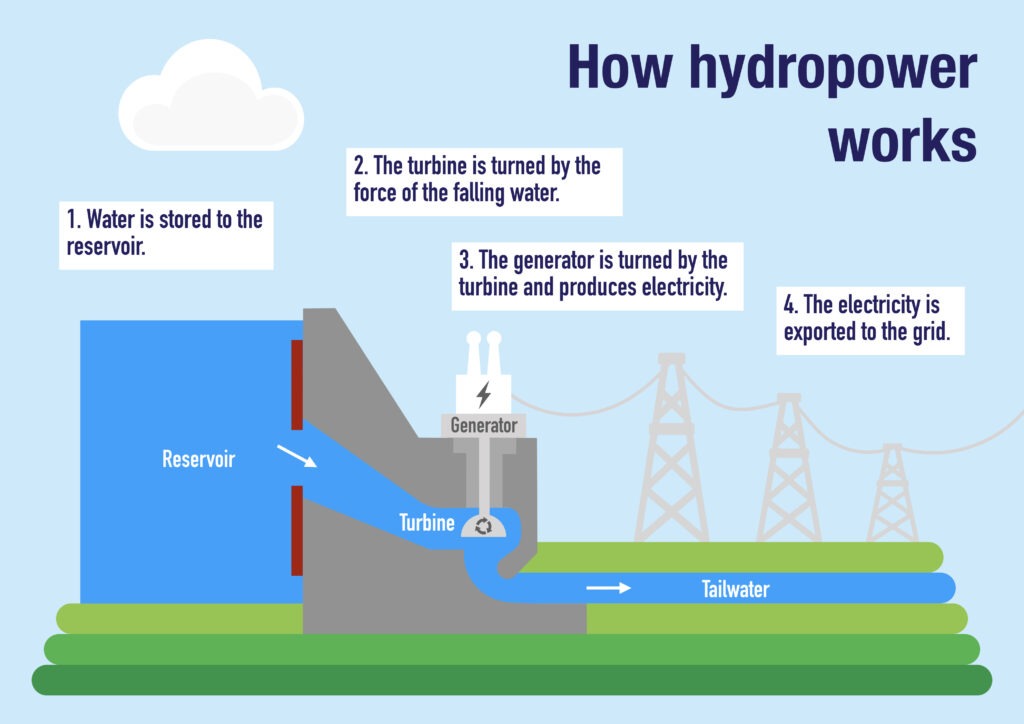In pursuing a sustainable future, the world constantly seeks innovative ways to generate clean and renewable energy. Unlocking the power of moving water (hydropower) represents a significant solution to our energy needs.
Among the many options available, hydropower is a testament to the age-old adage that sometimes the most powerful solutions lie right beneath our noses. Hydropower, or hydroelectric power, is generated by capturing the energy of moving water and converting it into electricity.
This technology harnesses the kinetic and potential energy stored in flowing water bodies like rivers, streams, and waterfalls. It has been used for centuries, dating back to ancient civilizations that used water wheels to grind grain and perform other mechanical tasks.
A glimpse into history
Using water to generate power is ancient, dating back to the Greeks and Romans who employed water wheels for grinding grain and pumping water. However, it was not until the late 19th century that hydropower began to take the form we recognize today.
The advent of the electric generator allowed the conversion of water’s kinetic energy into electrical energy on a larger scale. The Niagara Falls power station, constructed in 1882, marked a watershed moment in hydropower history and served as a model for future developments.
The modern era of hydropower
Today, hydropower is a major contributor to the global energy landscape. It accounts for approximately 16% of the world’s electricity production, making it the largest renewable energy source.
Nations like China, Brazil, Canada, and the United States are leaders in hydropower production, boasting an impressive array of hydroelectric dams and facilities.
How does hydropower work?

Hydropower’s popularity can be attributed to several factors; unlike fossil fuels, hydropower does not produce harmful greenhouse gases or air pollutants, significantly reducing carbon emissions and air pollution. Hydropower is one of the most reliable sources of renewable energy. It can provide a consistent and steady electricity supply, reducing the need for backup power sources.
Hydropower is not just a relic of the past; it’s a dynamic and sustainable energy source that can reshape our energy landscape for a brighter, greener future. As technology advances and environmental awareness grows, hydropower will play an increasingly vital role in reducing reliance on fossil fuels and combating climate change.
By harnessing water flow, we can tap into a clean, reliable, and abundant energy source, ultimately paving the way to a more sustainable world.
Hydropower represents a powerful solution to our growing energy needs, helping us combat climate change and reduce our reliance on fossil fuels. However, its potential remains largely untapped, and by investing in research, innovation, and sustainable practices, we can unlock even more of its benefits.
As we strive for a cleaner and greener energy future, hydropower is a testament to the incredible power of nature and human ingenuity working in harmony. It’s time to harness this potential and let the rivers of progress flow toward a more sustainable world.
It’s fascinating to see how an ancient technology has evolved to become a major contributor to global energy needs without emitting harmful greenhouse gases. Harnessing the kinetic energy of flowing water presents a reliable and clean alternative to fossil fuels. The point that much of hydropower’s potential remains untapped is both a challenge and an opportunity. Investing in this renewable resource could significantly advance our efforts against climate change. Overall, the article underscores the importance of embracing hydropower as a key component in the transition to a greener world.